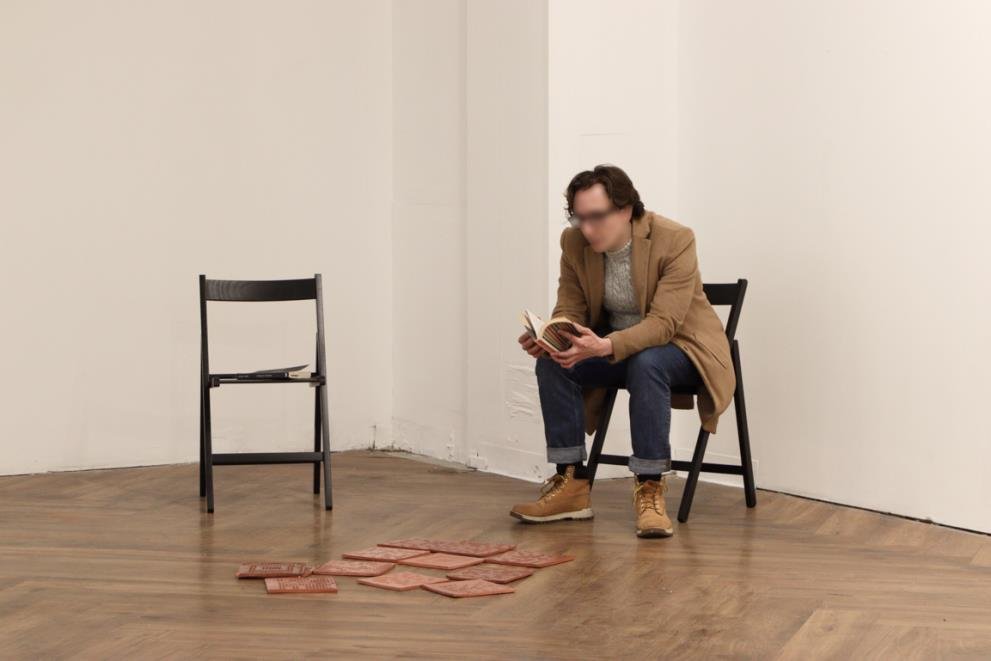
April 19 – May 19, 2024
Hypha Studios (London, UK)
Commissioned via Open Call
Working Space
:
One-third of a Slice
*
Working Space : One-third of a Slice *
Working Space: One-third of a Slice is an exhibition that reimagines the artist’s workspace not as a backdrop but as a site of negotiation, struggle, and subtle resistance. Hosted at Hypha Studios—an interim studio in East Village, Stratford—the show brought together seven emerging artists whose artworks confronted the precarity of creative labour through spatial poetics and material interventions. It drew on a wide range of practices including sculpture, embroidery, sound, video, and installation. The works and the space invited audiences into choreographies of looking, movement, and intimate encounter.
More than just a showcase of work, the exhibition unfolded as a porous inquiry—into absence as much as presence, into the limits of space and the urgencies that exceed them. Through a series of public programmes, the project opened multiple access points into the working conditions and quiet assertions of artistic life. As a fragment, a gesture, a third of a slice, the exhibition made just enough space to ask: what does it take—and what does it mean—to carve out a place to make?
-
To address the complex relationship between spatial limitations and artistic practice, exploring how absence, instability, or transience of workspaces can shape creative form and content.
-
Collaborative workshops
Artist interviews and studio visits - mapping of working conditions, spatial documentation through writing, drawing, and reflection exercises.
-
Case studies of artist-led spatial transformation
Socio-economic conditions of early-career practitioners in the UK
Feminist and decolonial spatial theory, emotional geographies of workspace, and collective authorship.
-
Curatorial Statement
Public Communication Digital Collateral
The creative writing workshop doubled as both research tool and public programme – narrative field notes, sensory ethnography, speculative fiction, first-person diary fragments, reflective prompts from pop culture and film media.
-
Hybrid exhibition comprising site-responsive artworks across sculpture, sound, video, embroidery, and installation
Series of public programme:
1. Screening of moving image works
2. Artists' panel talk and curator-led tour
3. Creative writing workshop
4. Textile-based workshops on embroidery, symbolism, and spatial storytelling


















Screening + Artists’ Talk
A one-night screening of moving image works, followed by a conversation between the artists and curator, invited audiences to rethink the boundaries between workspace and exhibition space—turning the gallery into a site of introspection and collective dialogue.
Creative Writing Workshop Where Am I?
This online workshop encouraged participants to reflect on their current work environments and dream up imagined ones—through writing, memory, and mood. The session created a space for storytelling, self-discovery, and shared vulnerability. The link below contains the full presentation, recording from the Where Am I? creative writing workshop, and a featured creative text produced by one of the participants. This archive offers a glimpse into the collective reflections and personal insights shaped during the session.
Embroidery & Textile Workshop Series
This hands-on day of workshops unfolded in three creative capsules led by Margarita Frančeska Ieva Loze, Alexandra Warren, and Tanvi Ranjan. Together, they invited participants to explore embroidery, symbolism, and collective narratives—threading personal memory into material form.
Related Works
Apart from the curatorial write-up in the press release, An Affair with the Working Space was written as a reflective curatorial essay by Nayanika that traces the layered relationship between art, space, and staging through the lens of the exhibition. Part memoir, part critique, it unpacks the challenges of long-distance curation, the semantics of seeing, and the exhibition’s material negotiations by a curator through presence, absence, and public perception. Featuring installation anecdotes, artist references, and field notes, this piece offers a deeper look into the exhibition’s spatial and conceptual framework.



